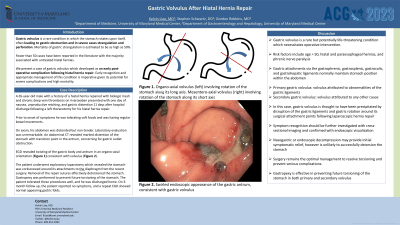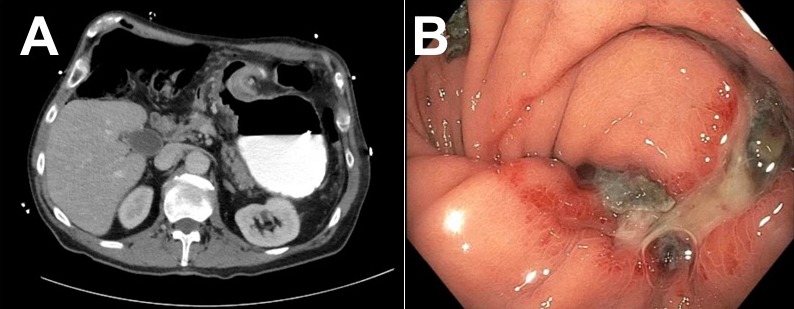Monday Poster Session
Category: Stomach
P2834 - Gastric Volvulus After Hiatal Hernia Repair
Monday, October 23, 2023
10:30 AM - 4:15 PM PT
Location: Exhibit Hall

Has Audio

Kelvin Liao, MD
University of Maryland School of Medicine
Baltimore, MD
Presenting Author(s)
Kelvin Liao, MD1, Stephen Schwartz, DO2, Gordon Robbins, MD3
1University of Maryland School of Medicine, Baltimore, MD; 2University of Maryland Medical System, Baltimore, MD; 3University of Maryland Medical Center, Baltimore, MD
Introduction: Gastric volvulus is a rare condition in which the stomach rotates upon itself, often leading to gastric obstruction and in severe cases strangulation and perforation. Mortality of gastric strangulation is estimated to be as high as 50%. Fewer than 50 cases have been reported in the literature with the majority associated with untreated hiatal hernias. We present a case of gastric volvulus which developed as an early post-operative complication following hiatal hernia repair. Early recognition and appropriate management of this condition is imperative given its potential for severe complications and high mortality.
Case Description/Methods: Our patient is a 65-year-old male with a history of a hiatal hernia repaired with biologic mesh and chronic deep vein thrombosis on rivaroxaban. He presented with one day of nausea, unproductive retching, and gastric distention 11 days after hospital discharge following a left thoracotomy for his hiatal hernia repair. Prior to onset of symptoms he was tolerating soft foods and was having regular bowel movements. On exam, his abdomen was distended but non-tender. Laboratory evaluation was unremarkable. An abdominal CT revealed marked distention of the stomach with transition point in the antrum, concerning for gastric outlet obstruction. EGD revealed twisting of the gastric body and antrum in an organoaxial (short-axis) orientation consistent with volvulus (Figure 1). The patient underwent exploratory laparotomy which revealed the stomach was corkscrewed around its attachments to the diaphragm from the recent surgery. Removal of the repair sutures effectively detorsioned the stomach. Gastropexy was performed to prevent future torsioning of the stomach. The patient tolerated these procedures well, and he was discharged home. On 3-month follow up, the patient reported no symptoms, and a repeat EGD showed normal appearing gastric folds.
Discussion: Gastric volvulus is a rare but potentially life-threatening condition which necessitates operative intervention. An untreated hiatal hernia is a known risk factor, and, in this case, we present it as an early post-operative complication of hernia repair as well. In both instances, symptom recognition should be further investigated with cross-sectional imaging and confirmed with endoscopic visualization. Surgery remains the optimal management to resolve torsioning and prevent serious complications.

Disclosures:
Kelvin Liao, MD1, Stephen Schwartz, DO2, Gordon Robbins, MD3. P2834 - Gastric Volvulus After Hiatal Hernia Repair, ACG 2023 Annual Scientific Meeting Abstracts. Vancouver, BC, Canada: American College of Gastroenterology.
1University of Maryland School of Medicine, Baltimore, MD; 2University of Maryland Medical System, Baltimore, MD; 3University of Maryland Medical Center, Baltimore, MD
Introduction: Gastric volvulus is a rare condition in which the stomach rotates upon itself, often leading to gastric obstruction and in severe cases strangulation and perforation. Mortality of gastric strangulation is estimated to be as high as 50%. Fewer than 50 cases have been reported in the literature with the majority associated with untreated hiatal hernias. We present a case of gastric volvulus which developed as an early post-operative complication following hiatal hernia repair. Early recognition and appropriate management of this condition is imperative given its potential for severe complications and high mortality.
Case Description/Methods: Our patient is a 65-year-old male with a history of a hiatal hernia repaired with biologic mesh and chronic deep vein thrombosis on rivaroxaban. He presented with one day of nausea, unproductive retching, and gastric distention 11 days after hospital discharge following a left thoracotomy for his hiatal hernia repair. Prior to onset of symptoms he was tolerating soft foods and was having regular bowel movements. On exam, his abdomen was distended but non-tender. Laboratory evaluation was unremarkable. An abdominal CT revealed marked distention of the stomach with transition point in the antrum, concerning for gastric outlet obstruction. EGD revealed twisting of the gastric body and antrum in an organoaxial (short-axis) orientation consistent with volvulus (Figure 1). The patient underwent exploratory laparotomy which revealed the stomach was corkscrewed around its attachments to the diaphragm from the recent surgery. Removal of the repair sutures effectively detorsioned the stomach. Gastropexy was performed to prevent future torsioning of the stomach. The patient tolerated these procedures well, and he was discharged home. On 3-month follow up, the patient reported no symptoms, and a repeat EGD showed normal appearing gastric folds.
Discussion: Gastric volvulus is a rare but potentially life-threatening condition which necessitates operative intervention. An untreated hiatal hernia is a known risk factor, and, in this case, we present it as an early post-operative complication of hernia repair as well. In both instances, symptom recognition should be further investigated with cross-sectional imaging and confirmed with endoscopic visualization. Surgery remains the optimal management to resolve torsioning and prevent serious complications.

Figure: Figure 1. (A) CT abdomen with oral contrast showing gastric distention and abnormal twisting of the gastric antrum. (B) Swirled endoscopic appearance of the gastric antrum, consistent with gastric volvulus.
Disclosures:
Kelvin Liao indicated no relevant financial relationships.
Stephen Schwartz indicated no relevant financial relationships.
Gordon Robbins indicated no relevant financial relationships.
Kelvin Liao, MD1, Stephen Schwartz, DO2, Gordon Robbins, MD3. P2834 - Gastric Volvulus After Hiatal Hernia Repair, ACG 2023 Annual Scientific Meeting Abstracts. Vancouver, BC, Canada: American College of Gastroenterology.
